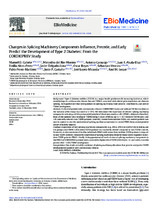Mostrar el registro sencillo del ítem
Changes in Splicing Machinery Components Influence, Precede, and Early Predict the Development of Type 2 Diabetes: From the CORDIOPREV Study
| dc.contributor.author | Gahete Ortiz, Manuel D. | |
| dc.contributor.author | Río Moreno, Mercedes del | |
| dc.contributor.author | Carpio Camargo, Antonio José | |
| dc.contributor.author | Alcalá Díaz, Juan Francisco | |
| dc.contributor.author | Alors-Pérez, Emilia | |
| dc.contributor.author | Delgado-Lista, Javier | |
| dc.contributor.author | Reyes Pupo, Oscar Gabriel | |
| dc.contributor.author | Ventura, Sebastián | |
| dc.contributor.author | Pérez Martínez, Pablo | |
| dc.contributor.author | Castaño, Justo P. | |
| dc.contributor.author | López Miranda, José | |
| dc.contributor.author | Luque, Raúl M. | |
| dc.date.accessioned | 2024-04-23T10:44:40Z | |
| dc.date.available | 2024-04-23T10:44:40Z | |
| dc.date.issued | 2018 | |
| dc.identifier.uri | http://hdl.handle.net/10396/27998 | |
| dc.description.abstract | Background: Type-2 diabetes mellitus (T2DM) is a major health problem with increasing incidence, which severely impacts cardiovascular disease. Because T2DM is associated with altered gene expression and aberrant splicing, we hypothesized that dysregulations in splicing machinery could precede, contribute to, and predict T2DM development. Methods: A cohort of patientswith cardiovascular disease (CORDIOPREV study) andwithout T2DMat baseline (at the inclusion of the study) was used (n=215). We determined the expression of selected splicing machinery components in fasting and 4 h-postprandial peripheral blood mononuclear cells (PBMCs, obtained at baseline) from all the patients who developed T2DM during 5-years of follow-up (n= 107 incident-T2DM cases) and 108 randomly selected non-T2DM patients (controls). Serum from incident-T2DM and control patients was used to analyze in vitro themodulation of splicingmachinery expression in control PBMCs from an independent cohort of healthy subjects. Findings: Expression of key splicing machinery components (e.g. RNU2, RNU4 or RNU12) from fasting and 4 h-postprandial PBMCs of incident-T2DM patients was markedly altered compared to non-T2DM controls. Moreover, in vitro treatment of healthy individuals PBMCs with serumfromincident-T2DM patients (compared to non-T2DM controls) reduced the expression of splicing machinery elements found down-regulated in incident- T2DM patients PBMCs. Finally, fasting/postprandial levels of several splicing machinery components in the PBMCs of CORDIOPREV patientswere associated to higher risk of T2DM(Odds Ratio N 4) and could accurately predict (AUC N 0.85) T2DM development. Interpretation: Our results reveal the existence of splicing machinery alterations that precede and predict T2DM development in patients with cardiovascular disease. Fund: ISCIII, MINECO, CIBERObn. | es_ES |
| dc.description.abstract | Este estudio exploró si las desregulaciones en la maquinaria de splicing podrían preceder, contribuir y predecir el desarrollo de diabetes mellitus tipo 2 (DMT2) ya que la DMT2 se asocia a una expresión génica alterada y a un splicing aberrante. Se utilizó una cohorte de pacientes con enfermedad cardiovascular (estudio CORDIOPREV) y sin DMT2 al inicio del estudio (n = 215). Se determinó la expresión de componentes seleccionados de la maquinaria de splicing en células mononucleares de sangre periférica (PBMC, obtenidas al inicio del estudio) en ayunas y 4 h-postprandiales de todos los pacientes que desarrollaron DMT2 durante 5 años de seguimiento (n = 107 casos de DMT2 incidente) y 108 pacientes sin DMT2 seleccionados al azar (controles). Se utilizó suero de pacientes con DMT2 incidente y de pacientes de control para analizar in vitro la modulación de la expresión de la maquinaria de splicing en PBMC de control procedentes de una cohorte independiente de sujetos sanos. El estudio demostró que la expresión de componentes clave de la maquinaria de splicing (por ejemplo, RNU2, RNU4 o RNU12) de PBMCs en ayunas y 4 h-postprandiales de pacientes con DMT2 incidental estaba marcadamente alterada en comparación con los controles sin DMT2. Además, el tratamiento in vitro de las PBMC de individuos sanos con suero de pacientes con DMT2 incidental (en comparación con los controles sin DMT2) redujo la expresión de los elementos de la maquinaria de splicing que se encontraban regulados a la baja en las PBMC de pacientes con DMT2 incidental. Por último, los niveles en ayunas/postprandiales de varios componentes de la maquinaria de splicing en las PBMC de pacientes CORDIOPREV se asociaron a un mayor riesgo de DMT2 (Odds Ratio > 4) y podrían predecir con exactitud (AUC > 0,85) el desarrollo de DMT2. | |
| dc.format.mimetype | application/pdf | es_ES |
| dc.language.iso | eng | es_ES |
| dc.publisher | Elsevier | es_ES |
| dc.rights | https://creativecommons.org/licenses/by-nc-nd/4.0/ | es_ES |
| dc.source | Manuel D. Gahete, Mercedes del Rio-Moreno, Antonio Camargo, Juan F. Alcala-Diaz, Emilia Alors-Perez, Javier Delgado-Lista, Oscar Reyes, Sebastian Ventura, Pablo Perez-Martínez, Justo P. Castaño, José Lopez-Miranda, Raul M. Luque, Changes in Splicing Machinery Components Influence, Precede, and Early Predict the Development of Type 2 Diabetes: From the CORDIOPREV Study, EBioMedicine, Volume 37, 2018. | es_ES |
| dc.subject | Peripheral blood mononuclear cells (PBMCs) | es_ES |
| dc.subject | Postprandial state | es_ES |
| dc.subject | Spliceosome | es_ES |
| dc.subject | OGTT | es_ES |
| dc.subject | RNUs | es_ES |
| dc.title | Changes in Splicing Machinery Components Influence, Precede, and Early Predict the Development of Type 2 Diabetes: From the CORDIOPREV Study | es_ES |
| dc.type | info:eu-repo/semantics/article | es_ES |
| dc.relation.publisherversion | https://doi.org/10.1016/j.ebiom.2018.10.056 | es_ES |
| dc.rights.accessRights | info:eu-repo/semantics/openAccess | es_ES |

